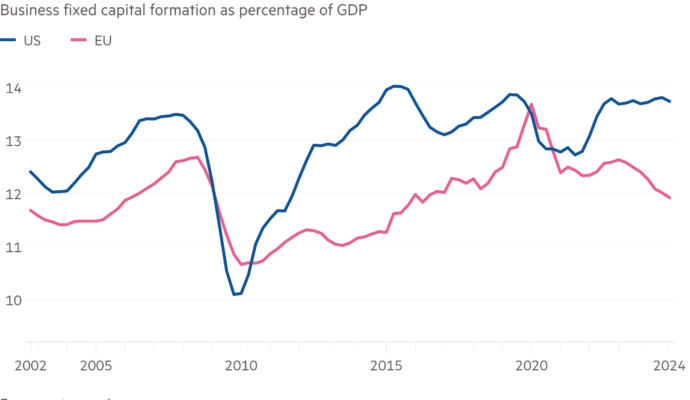Unlock the Editor’s Digest for free
Roula Khalaf, Editor of the FT, selects her favourite stories in this weekly newsletter.
Now where were we? In my last Skin in the Game column I said three issues were making me especially nervous at the moment. “Which way the dollar is heading and ditto for inflation and rates globally.”
I only covered the first of these, but I recommend reading my lovely colleague Katie Martin this week to understand why all portfolio managers are struggling with the dollar. (I’ve forgiven her for live blogging the Miami underwater joke that got me fired.)
So providing total war isn’t about to erupt in the Middle East, it’s on to inflation and bond prices — the latter being the inverse of yields. But hang on a minute, I hear some readers cry. You have written before that “investors needn’t lose sleep over rates”. And the same for inflation.
Indeed I have. Let me quickly summarise what I said for those who missed it. Pull up a long-run chart of any equity market and it correlates not a jot with bond yields. Stocks love rising rates as much as falling ones.
In theory, why shouldn’t they? The mistake people make when supposing yields up equals stocks down is that they forget that a higher discount rate usually reflects stronger demand and hence revenues need lifting as well.
In valuation models the two cancel each other out. Likewise, most income and balance sheet items are real items, therefore inflation shouldn’t change the worth of the company much either, except in nominal terms.
But such things are not what I had in mind when I wrote that inflation and bond yields are worrying me. It’s more existential. If the world is fine, with stocks rebounding since April, tariffs yet to feed through to prices, and short-term rates steady, why have gold and bitcoin rallied?
I don’t like it. Similarly, the long end of the yield curve in countries from the US and Japan to Germany and Australia — that is, for example the rate at which their governments can borrow money over 30 years — has begun to drift upwards.
To me it feels as if investors are saying: “We are fine with the outlook for the global economy as well as for companies and bonds now. It’s just the entire underpinnings of modern capitalism and finance we are concerned about.”
Not only is it individuals and institutions who are hoarding such assets they hope will withstand a crisis. Central banks are forklifting a fifth of world’s production of gold into their vaults each year — twice as much as a decade ago.
Not everyone is saying armageddonoutofhere, of course. If they were, asset prices would be tanking across the world. And the fact is these fears relate quite specifically, it seems to me, to soaring levels of sovereign debt.
For those worried about the solvency of governments, or who reckon fiat money’s time has come, it makes sense to buy gold and bitcoin — even if in the short run you’re bullish on equities or think artificial intelligence will boost productivity.
And, of course, everyone with a retirement pot always needs to remember how important it is to factor in inflation when making investment decisions.
But what I’m saying is that some investors are clearly preparing for an inflation megabomb. As one analyst I follow recommended this week: “Sixty per cent of your portfolio should be in assets that if they fell on your foot it would hurt. The rest should be in equities.”
This is your textbook “end of days” allocation. Lots of real assets such as gold, wine and classic cars — as well as a chunk in equities for the income or in case everything turns out fine after all. You can even get a bruise from a bitcoin wallet if you drop it from high enough.
I’m not sure this is the right way to go for most of us, however. For many readers, your biggest asset will be your home. Bricks and mortar are a fabulous hedge against inflation (and state malfunction) as third world residents know too well.
What is more, you’re betting against a downward trend in 30-year bond yields that has lasted decades until recently. Sure they have popped in the US as successive administrations lost control of spending. And it’s hard to believe yields in Germany are now 3 per cent. From the summer of 2019 they struggled to be positive for two and half years!
Sure, there are reasons why “normalised” yields may be higher than they have been in the recent past — as I wrote a month ago. But for me at least, the strongest forces in the world — demographics, technology and competition — still remain huge dampers on prices.
Plus, I have faith that the discipline that bond (and equity) markets bring to government behaviour (as we have already seen with Donald Trump and tariffs) will temper excesses way before they become major crises.
What does all this mean for my portfolio? It has done extremely well since April after switching Treasuries into stocks and I am happy running this for a while yet. My chosen equity markets remain cheap on a price-to-book basis and don’t forget that book values — that is balance sheets — rise with inflation too, as do company revenues.
The only concern I have, if I’m being logical, is that if governments do start minding their finances and spend less, as I hope above, this will feed through to weaker earnings, all else being equal. Lower deficits equal lower profits, according to the so-called Kalecki-Levy identity in economics.
But, frankly, I would have to see pretty firm evidence that politicians have got on top of welfare expenditure before worrying about that happening. There’s more chance my wife reads this and decides to sell her own gold jewellery.
The author is a former portfolio manager. Email: stuart.kirk@ft.com; X: @stuartkirk__


